Jinfeng Rao
Improving Pinterest Search Relevance Using Large Language Models
Oct 22, 2024



Abstract:To improve relevance scoring on Pinterest Search, we integrate Large Language Models (LLMs) into our search relevance model, leveraging carefully designed text representations to predict the relevance of Pins effectively. Our approach uses search queries alongside content representations that include captions extracted from a generative visual language model. These are further enriched with link-based text data, historically high-quality engaged queries, user-curated boards, Pin titles and Pin descriptions, creating robust models for predicting search relevance. We use a semi-supervised learning approach to efficiently scale up the amount of training data, expanding beyond the expensive human labeled data available. By utilizing multilingual LLMs, our system extends training data to include unseen languages and domains, despite initial data and annotator expertise being confined to English. Furthermore, we distill from the LLM-based model into real-time servable model architectures and features. We provide comprehensive offline experimental validation for our proposed techniques and demonstrate the gains achieved through the final deployed system at scale.
DSI++: Updating Transformer Memory with New Documents
Dec 19, 2022Abstract:Differentiable Search Indices (DSIs) encode a corpus of documents in the parameters of a model and use the same model to map queries directly to relevant document identifiers. Despite the strong performance of DSI models, deploying them in situations where the corpus changes over time is computationally expensive because reindexing the corpus requires re-training the model. In this work, we introduce DSI++, a continual learning challenge for DSI to incrementally index new documents while being able to answer queries related to both previously and newly indexed documents. Across different model scales and document identifier representations, we show that continual indexing of new documents leads to considerable forgetting of previously indexed documents. We also hypothesize and verify that the model experiences forgetting events during training, leading to unstable learning. To mitigate these issues, we investigate two approaches. The first focuses on modifying the training dynamics. Flatter minima implicitly alleviate forgetting, so we optimize for flatter loss basins and show that the model stably memorizes more documents (+12\%). Next, we introduce a generative memory to sample pseudo-queries for documents and supplement them during continual indexing to prevent forgetting for the retrieval task. Extensive experiments on novel continual indexing benchmarks based on Natural Questions (NQ) and MS MARCO demonstrate that our proposed solution mitigates forgetting by a significant margin. Concretely, it improves the average Hits@10 by $+21.1\%$ over competitive baselines for NQ and requires $6$ times fewer model updates compared to re-training the DSI model for incrementally indexing five corpora in a sequence.
Transcending Scaling Laws with 0.1% Extra Compute
Oct 20, 2022



Abstract:Scaling language models improves performance but comes with significant computational costs. This paper proposes UL2R, a method that substantially improves existing language models and their scaling curves with a relatively tiny amount of extra compute. The key idea is to continue training a state-of-the-art large language model (e.g., PaLM) on a few more steps with UL2's mixture-of-denoiser objective. We show that, with almost negligible extra computational costs and no new sources of data, we are able to substantially improve the scaling properties of large language models on downstream metrics. In this paper, we continue training PaLM with UL2R, introducing a new set of models at 8B, 62B, and 540B scale which we call U-PaLM. Impressively, at 540B scale, we show an approximately 2x computational savings rate where U-PaLM achieves the same performance as the final PaLM 540B model at around half its computational budget (i.e., saving $\sim$4.4 million TPUv4 hours). We further show that this improved scaling curve leads to 'emergent abilities' on challenging BIG-Bench tasks -- for instance, U-PaLM does much better than PaLM on some tasks or demonstrates better quality at much smaller scale (62B as opposed to 540B). Overall, we show that U-PaLM outperforms PaLM on many few-shot setups, i.e., English NLP tasks (e.g., commonsense reasoning, question answering), reasoning tasks with chain-of-thought (e.g., GSM8K), multilingual tasks (MGSM, TydiQA), MMLU and challenging BIG-Bench tasks. Finally, we provide qualitative examples showing the new capabilities of U-PaLM for single and multi-span infilling.
Scaling Laws vs Model Architectures: How does Inductive Bias Influence Scaling?
Jul 21, 2022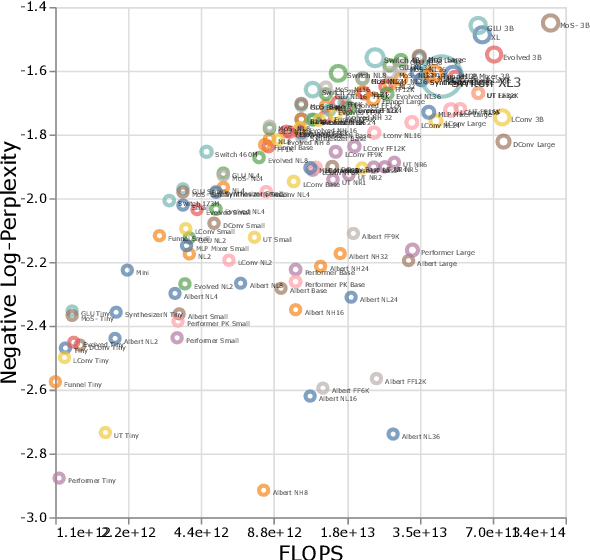
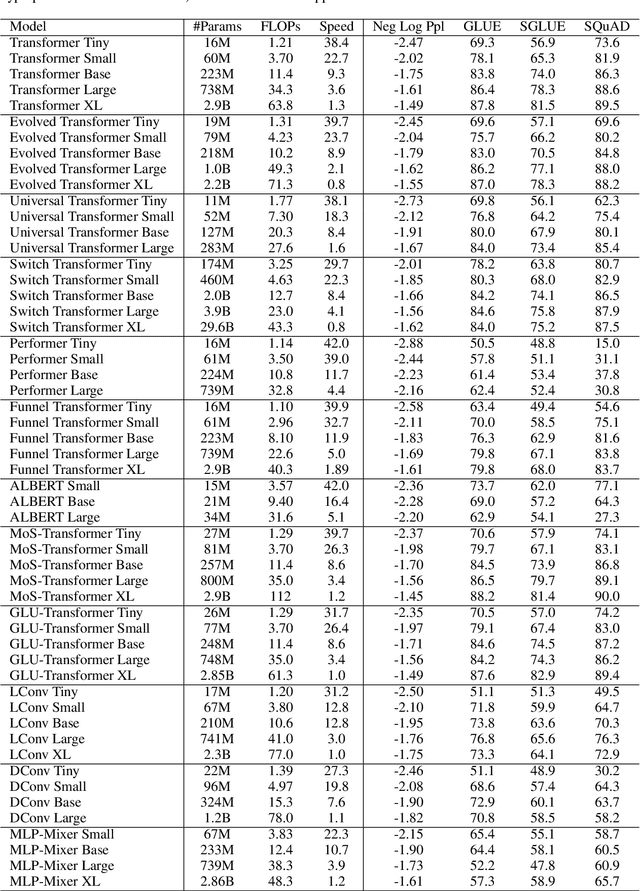
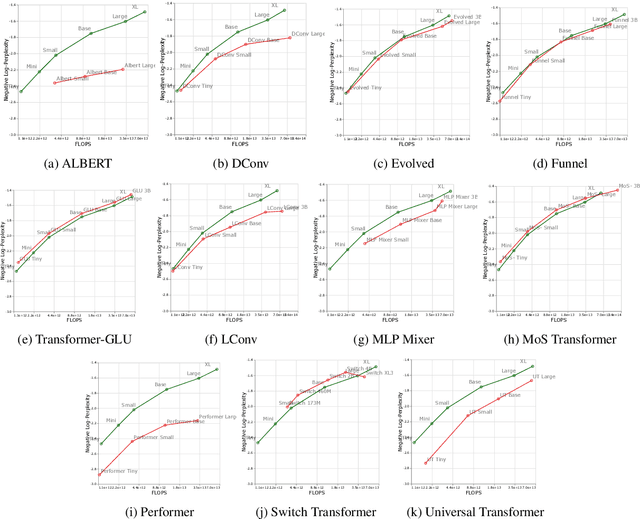
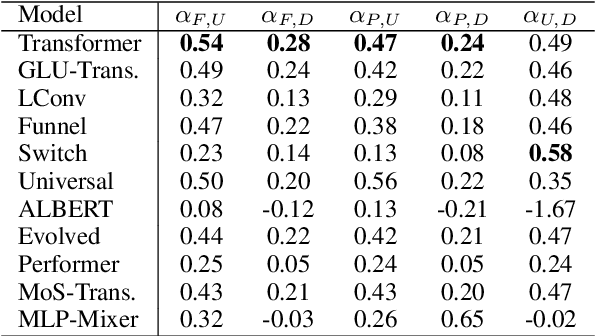
Abstract:There have been a lot of interest in the scaling properties of Transformer models. However, not much has been done on the front of investigating the effect of scaling properties of different inductive biases and model architectures. Do model architectures scale differently? If so, how does inductive bias affect scaling behaviour? How does this influence upstream (pretraining) and downstream (transfer)? This paper conducts a systematic study of scaling behaviour of ten diverse model architectures such as Transformers, Switch Transformers, Universal Transformers, Dynamic convolutions, Performers, and recently proposed MLP-Mixers. Via extensive experiments, we show that (1) architecture is an indeed an important consideration when performing scaling and (2) the best performing model can fluctuate at different scales. We believe that the findings outlined in this work has significant implications to how model architectures are currently evaluated in the community.
ExT5: Towards Extreme Multi-Task Scaling for Transfer Learning
Nov 22, 2021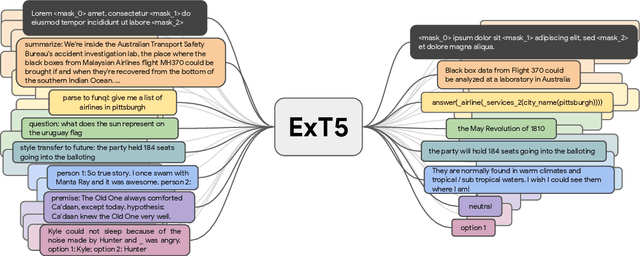
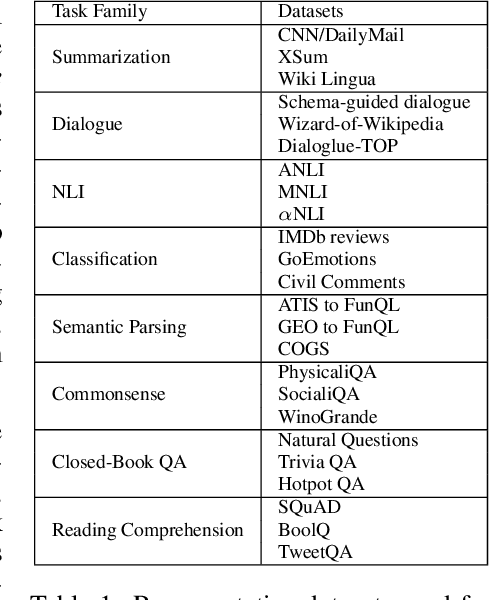
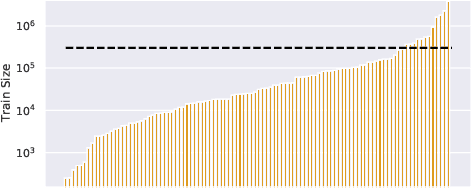
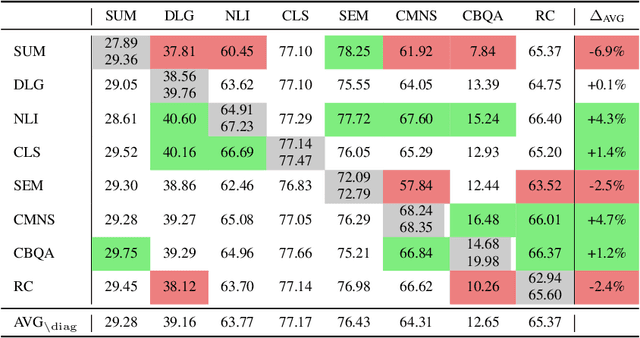
Abstract:Despite the recent success of multi-task learning and transfer learning for natural language processing (NLP), few works have systematically studied the effect of scaling up the number of tasks during pre-training. Towards this goal, this paper introduces ExMix (Extreme Mixture): a massive collection of 107 supervised NLP tasks across diverse domains and task-families. Using ExMix, we study the effect of multi-task pre-training at the largest scale to date, and analyze co-training transfer amongst common families of tasks. Through this analysis, we show that manually curating an ideal set of tasks for multi-task pre-training is not straightforward, and that multi-task scaling can vastly improve models on its own. Finally, we propose ExT5: a model pre-trained using a multi-task objective of self-supervised span denoising and supervised ExMix. Via extensive experiments, we show that ExT5 outperforms strong T5 baselines on SuperGLUE, GEM, Rainbow, Closed-Book QA tasks, and several tasks outside of ExMix. ExT5 also significantly improves sample efficiency while pre-training.
Improving Compositional Generalization with Self-Training for Data-to-Text Generation
Oct 16, 2021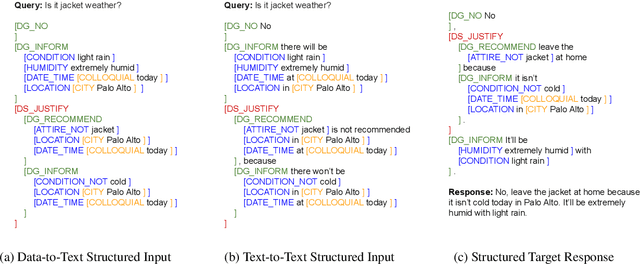



Abstract:Data-to-text generation focuses on generating fluent natural language responses from structured semantic representations. Such representations are compositional, allowing for the combination of atomic meaning schemata in various ways to express the rich semantics in natural language. Recently, pretrained language models (LMs) have achieved impressive results on data-to-text tasks, though it remains unclear the extent to which these LMs generalize to new semantic representations. In this work, we systematically study the compositional generalization of current state-of-the-art generation models in data-to-text tasks. By simulating structural shifts in the compositional Weather dataset, we show that T5 models fail to generalize to unseen structures. Next, we show that template-based input representations greatly improve the model performance and model scale does not trivially solve the lack of generalization. To further improve the model's performance, we propose an approach based on self-training using finetuned BLEURT for pseudo-response selection. Extensive experiments on the few-shot Weather and multi-domain SGD datasets demonstrate strong gains of our method.
Scale Efficiently: Insights from Pre-training and Fine-tuning Transformers
Sep 22, 2021
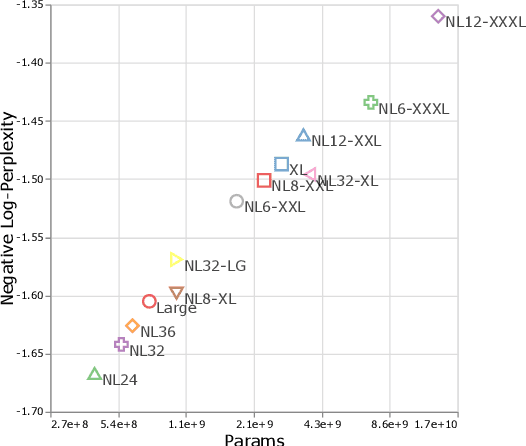
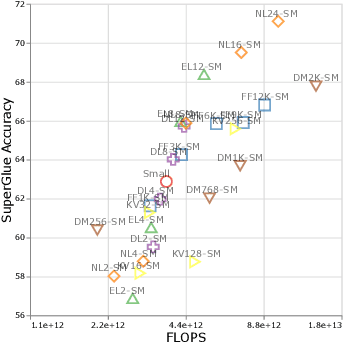

Abstract:There remain many open questions pertaining to the scaling behaviour of Transformer architectures. These scaling decisions and findings can be critical, as training runs often come with an associated computational cost which have both financial and/or environmental impact. The goal of this paper is to present scaling insights from pretraining and finetuning Transformers. While Kaplan et al. presents a comprehensive study of the scaling behaviour of Transformer language models, the scope is only on the upstream (pretraining) loss. Therefore, it is still unclear if these set of findings transfer to downstream task within the context of the pretrain-finetune paradigm. The key findings of this paper are as follows: (1) we show that aside from only the model size, model shape matters for downstream fine-tuning, (2) scaling protocols operate differently at different compute regions, (3) widely adopted T5-base and T5-large sizes are Pareto-inefficient. To this end, we present improved scaling protocols whereby our redesigned models achieve similar downstream fine-tuning quality while having 50\% fewer parameters and training 40\% faster compared to the widely adopted T5-base model. We publicly release over 100 pretrained checkpoints of different T5 configurations to facilitate future research and analysis.
Long Range Arena: A Benchmark for Efficient Transformers
Nov 08, 2020



Abstract:Transformers do not scale very well to long sequence lengths largely because of quadratic self-attention complexity. In the recent months, a wide spectrum of efficient, fast Transformers have been proposed to tackle this problem, more often than not claiming superior or comparable model quality to vanilla Transformer models. To this date, there is no well-established consensus on how to evaluate this class of models. Moreover, inconsistent benchmarking on a wide spectrum of tasks and datasets makes it difficult to assess relative model quality amongst many models. This paper proposes a systematic and unified benchmark, LRA, specifically focused on evaluating model quality under long-context scenarios. Our benchmark is a suite of tasks consisting of sequences ranging from $1K$ to $16K$ tokens, encompassing a wide range of data types and modalities such as text, natural, synthetic images, and mathematical expressions requiring similarity, structural, and visual-spatial reasoning. We systematically evaluate ten well-established long-range Transformer models (Reformers, Linformers, Linear Transformers, Sinkhorn Transformers, Performers, Synthesizers, Sparse Transformers, and Longformers) on our newly proposed benchmark suite. LRA paves the way towards better understanding this class of efficient Transformer models, facilitates more research in this direction, and presents new challenging tasks to tackle. Our benchmark code will be released at https://github.com/google-research/long-range-arena.
Constrained Decoding for Neural NLG from Compositional Representations in Task-Oriented Dialogue
Jun 17, 2019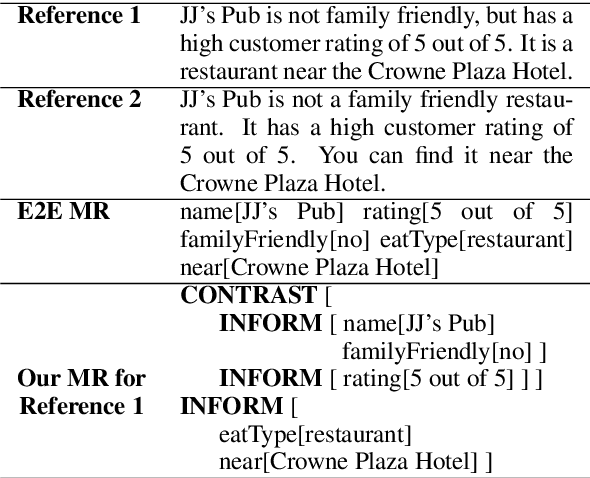
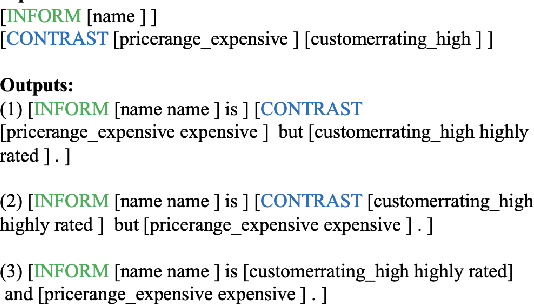

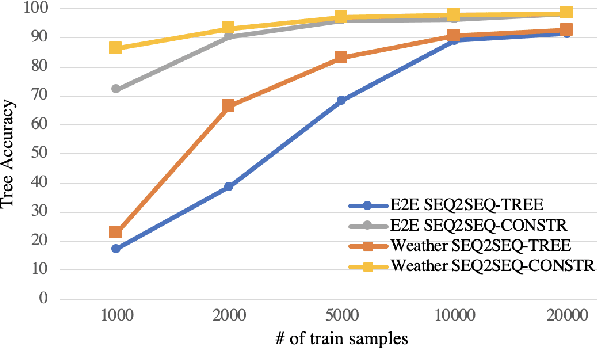
Abstract:Generating fluent natural language responses from structured semantic representations is a critical step in task-oriented conversational systems. Avenues like the E2E NLG Challenge have encouraged the development of neural approaches, particularly sequence-to-sequence (Seq2Seq) models for this problem. The semantic representations used, however, are often underspecified, which places a higher burden on the generation model for sentence planning, and also limits the extent to which generated responses can be controlled in a live system. In this paper, we (1) propose using tree-structured semantic representations, like those used in traditional rule-based NLG systems, for better discourse-level structuring and sentence-level planning; (2) introduce a challenging dataset using this representation for the weather domain; (3) introduce a constrained decoding approach for Seq2Seq models that leverages this representation to improve semantic correctness; and (4) demonstrate promising results on our dataset and the E2E dataset.
Lightweight and Efficient Neural Natural Language Processing with Quaternion Networks
Jun 11, 2019



Abstract:Many state-of-the-art neural models for NLP are heavily parameterized and thus memory inefficient. This paper proposes a series of lightweight and memory efficient neural architectures for a potpourri of natural language processing (NLP) tasks. To this end, our models exploit computation using Quaternion algebra and hypercomplex spaces, enabling not only expressive inter-component interactions but also significantly ($75\%$) reduced parameter size due to lesser degrees of freedom in the Hamilton product. We propose Quaternion variants of models, giving rise to new architectures such as the Quaternion attention Model and Quaternion Transformer. Extensive experiments on a battery of NLP tasks demonstrates the utility of proposed Quaternion-inspired models, enabling up to $75\%$ reduction in parameter size without significant loss in performance.
 Add to Chrome
Add to Chrome Add to Firefox
Add to Firefox Add to Edge
Add to Edge